You may be surprised by the variety of on-demand apps that have online appointment scheduling as one of their core features. Just look at Seamless, TaskRabbit, Squire, and even Uber. Booking appointments online has also become a breakthrough feature for health insurance companies like Oscar, driving sales and virality.
However, there are still a lot of sports centers, private clinics, cleaning companies, beauty salons, schools, and other organizations that schedule meetings over the phone, manually add bookings to Google Calendar, and register customers in an Excel file that regularly breaks.
These procedures are time-consuming and often lead to mistakes or even monetary losses. Moreover, by staying offline, companies are missing out on a giant piece of the cake: Online bookings allow businesses to get a significant revenue increase and a more stable customer flow.
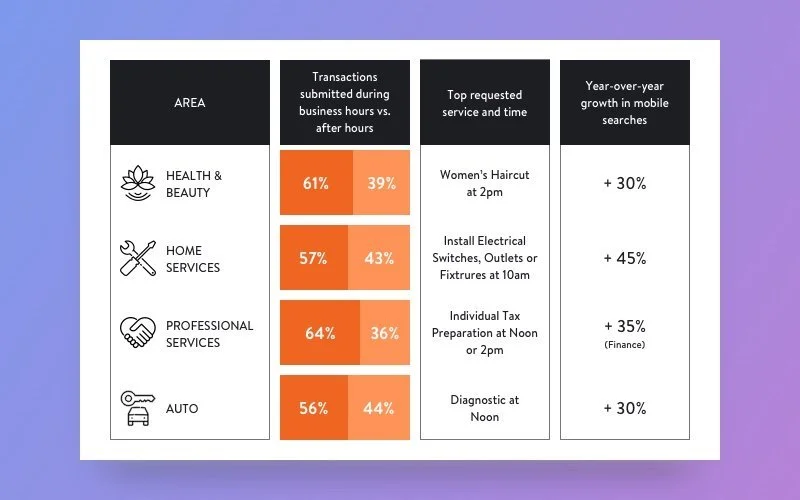
As you can see in the graphic above based on findings by industry experts from Pingup, by simply allowing users to book online when business hours are over, businesses can expect a revenue increase of 30 to 45 percent, depending on the industry. But online appointment scheduling isn’t one single feature. It’s a complex solution that:
- helps you attract and retain customers, as they can easily find and connect with professionals
- streamlines the management of customers, employees, and appointments
- brings more accuracy allowing for tracking reports and saves businesses a lot of time and money
This is why businesses need to automate appointment scheduling. Complex appointment scheduling functionality should become part of a company’s official website or loyalty app – for example, for a chain of beauty salons all around the US.
The post you’re reading is based on our extensive experience regarding services of developing online appointment systems. The tips you’ll find here apply to any business domain. Let’s first see what your appointment scheduling software should be able to do.

Optimize healthcare workflow with online scheduling
Integrate an appointment booking solution to deliver a more flexible patient experience
Book appointments
Allowing clients to book online can bring you more sales. To make this happen, online bookings should be simple and convenient. Your customers should be able to directly interact with your booking service on your website and in your app, and your booking tool should give them a listing of your services and service providers, plus dates and times to choose from.
In order for users to see all these details, you’ll need your own custom content management system. It should contain information about your services, booking times, the duration of each service, prices, pictures, and descriptions. This booking system should also assign employees to services.
Some of your customers might not have any preferences among service providers, so it would be a good idea to allow the option of booking with any available service provider.
Let’s look at the service management tool provided by one of the top appointment scheduling apps, Simply Book:
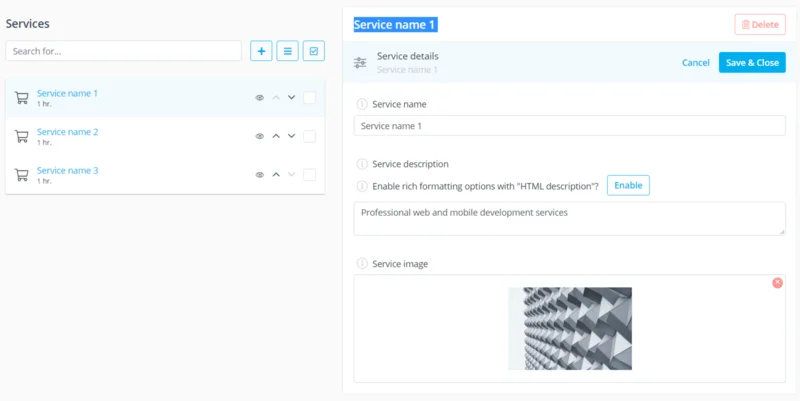
After a customer selects a service, service provider, and time in Simply Book, they can complete the booking, scheduling a single or recurring appointment (for example, a series of classes). To complete the booking, the customer needs to enter their contact details and, if necessary, add a comment to clarify details.
Types of booking flows
There are two basic types of booking flows:
Guest bookings. A user enters their name and an email address or phone number but doesn’t create a profile. With this method, users have to enter their contact details every time they book an appointment.
Bookings via a user profile. This booking flow can be used for logging in to the app, getting personalized offers and discounts, tracking bonuses, and more. To let customers create user profiles and register with your service, you can integrate with Facebook and Google authentication APIs. You can also offer users simple registration via email or phone number. More options including using SMS or voice verification APIs by Sinch, Twilio, or Vonage to verify a customer’s phone number.
Appointment visibility for customers
It would be a great idea to allow users to add confirmed bookings to their personal calendars for convenient event planning (Google Calendar, iCalendar, Outlook, Yahoo!) right from the web or mobile app interface.
For customers that don’t use calendar apps, you can give an option to get SMS appointment reminders (consider adding options like two or four hours before). To send SMS messages to your customers, you can integrate Twilio or Vonage.
Registering for group appointments
You can also let multiple users register for the same appointment if you’re providing services like math or yoga classes, fitness trainings, or makeup workshops to groups.
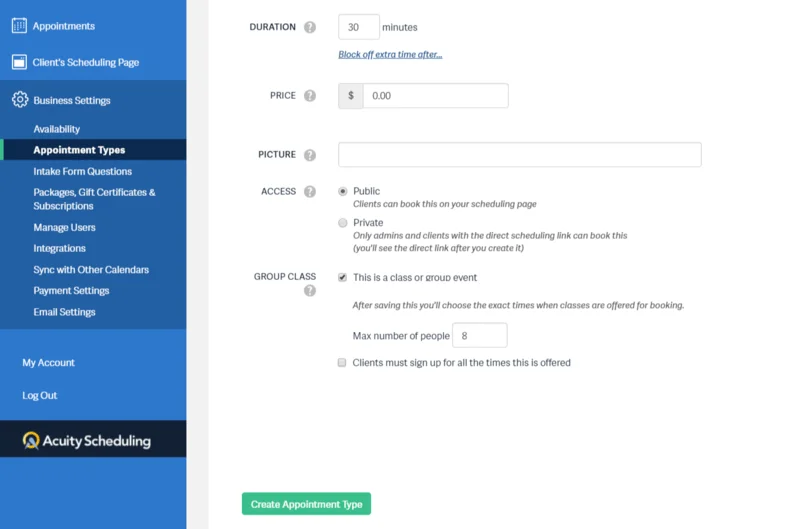
Improving your service and efficiency
In addition to booking appointments, users should be able to reschedule or cancel appointments. In our experience, customers should be able to cancel visits in response to appointment notifications, which reduces the problem of skipped appointments. When a customer cancels, another customer will be able to book the open slot and you won’t lose money at the last moment.
You should also give users a tool to explain why they’re canceling or rescheduling. When developing Healthfully, we went even further to help clinicians collect patient data.
When a patient has an appointment scheduled in Healthfully, they receive surveys specific to their health condition. When a patient fills out a survey, their physician receives the results so they can prepare for the appointment. This makes an online reservation system a great tool for improving the quality of customer service.
You might also need to implement a video call feature to provide consultations. The COVID-19 pandemic has increased the demand for touchless interactions, but this newfound demand is likely to outlast the pandemic.
Manage appointments
It’s a good idea to keep all data about your bookings within an all-in-one scheduling system. It’s way easier to monitor appointments when a calendar can show pending and scheduled appointments, estimate the workload of employees, and show when they’re available. That’s where you’ll need to decide whether to choose a ready-made cloud-based software solution for managing bookings or a custom cloud calendar.
Off-the-shelf appointment management software vs developed from scratch
Square Appointments is just one example of a comprehensive appointment scheduling calendar for service-based businesses. Using the cloud-based Square Appointments calendar, businesses are able to see all current and upcoming bookings, check appointment details, and approve and cancel appointments as necessary.
If you already use a certain tool for managing bookings and you’re satisfied with how it functions, think of integrating it and importing all of your previously created bookings to your online scheduling portal or an app as part of online appointment software development.
In general, if you’re a small to midsize business, it’s likely that ready-made tools or multi-user calendars for managing bookings will be enough for your needs. But if you’re a large business, you’ll likely find the functionality and customizability of such solutions lacking and turn your attention to customized software development.
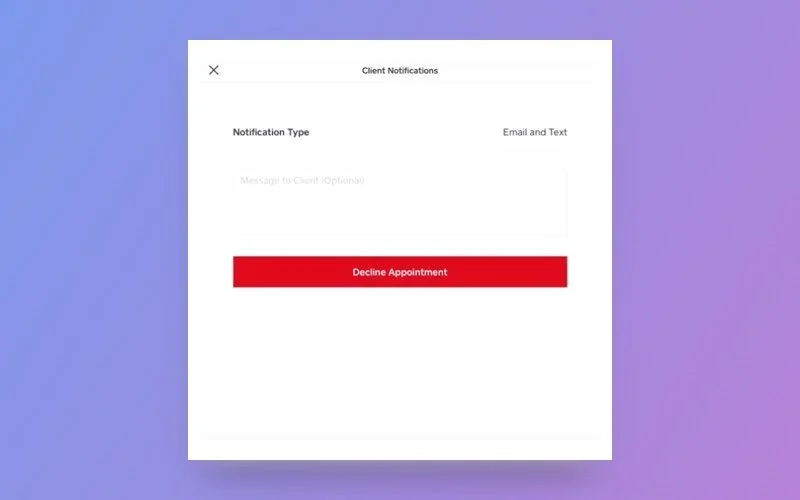
Manual appointment processing
Make sure your ready-made or custom appointment calendar platform allows your staff to manage appointments and avoid making mistakes.
Adding, approving, and canceling appointments. Enable employees to manually approve and cancel appointments and mention reasons for canceling. Employees should also be able to manually add new appointments to the system, as people may still sign up by phone (for example, for a doctor’s appointment).
Navigating notifications sent to customers. In Square Appointments, managers can choose among different types of notifications when manually approving appointments and informing that an appointment is successfully scheduled. They can even add personalized text to these notifications.
Assigning appointment statuses. To simplify appointment management for Yalantis clients, we implement appointment statuses for excellent visibility. Examples of statuses are out, canceled, no-show, arrived, confirmed, and new.
Minimizing human error. Along with ensuring appointment scheduling flexibility, manual processing increases the possibility of human error. For our projects, we implement a smart system that helps our clients’ employees avoid mistakes. When there’s a new visit request in the system, responsible employees see a notification until they confirm the request. When there are booked visits within an available time slot, an employee can’t delete that time slot until they shift the visits to another time slot.
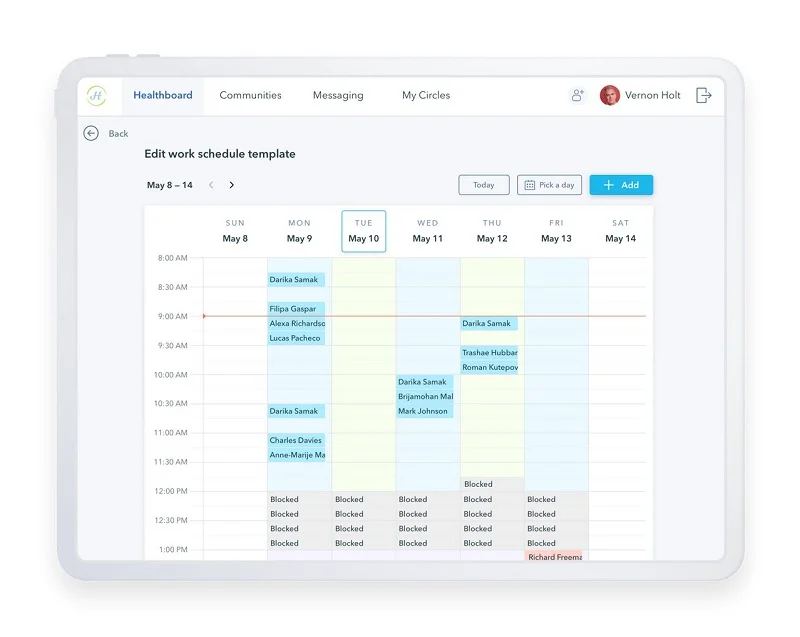
Establish employee management
Businesses like hair salons often have several service providers (in the case of hair salons, stylists) that customers can choose from. This is why it’s important to have a tool to add, delete, and edit the list of service providers.
Simply Book allows businesses to create a page for each service provider, including their name, contact information, and photos. Businesses can edit, hide, and delete service provider profiles.
Different employees in your company may have different goals and daily tasks. That’s why your automated scheduling tool should support different user roles to help employees do their jobs effectively. These roles are just examples, and you can develop your own with a more or less complicated hierarchy:
-
Admin – full access to all services, schedules, service providers, customers, management sections, tariffs, payments, and settings
-
Senior employee – access to all service providers, schedules, and customers
-
Employee – access to the user’s own schedules and customers
-
Viewer – access to view some schedules and customer details or any other limited information
Another good idea for businesses with multiple employees is to integrate with a human capital management (HCM) system like BambooHR. An HCM system will show you the workload of your employees and help you properly distribute time slots between workers when some are on sick leave or vacation.
For instance, let’s say Jack, your hairdresser, takes two weeks off to visit his family. Your HCM system notifies you and your employees that Jack is going on vacation so you can inform his clients and assign them to other hairdressers.
Another example of how you can use an HCM system is to track your employees’ work time. Let’s say you own a cleaning company and all your workers have to check in with an electronic badge when they come to work. Your HCM system can let you know if an employee is late so you can contact your customers and let them either choose another employee or wait.
Manage customers
Every business wants regular and long-term customers. To get them, service providers need a powerful tool to find, register, and contact users, inform them of new services, and use contact information for marketing purposes. All of that can be done with the help of a customer relationship management (CRM) system that provides information about your customers, their purchase history, and notes from employees.
One option is to build your own CRM system with custom fields, which might take some time. Another option is to integrate an advanced CRM solution like PipeDrive, Salesforce, or HubSpot to better interact with customers and know the actual number of sales accounting for no-shows and canceled appointments.
You should be able to add customers to your system manually or import customer information from an existing Excel file or Google Sheets document.
With all this information in hand, you can easily nurture your customers with personalized emails, inviting them to an exclusive workshop with a special discount, for example. And for marketing purposes, you’ll definitely appreciate integrations with:
- email services like MailChimp to send email campaigns
- customer engagement services like ReferralCandy to hold referral campaigns
- social media networks like Facebook and Instagram to book appointments and advertise
Receive payments
You can accept online payments by integrating with Braintree, PayPal, Stripe, or Square. Find out more about integrating a payment gateway in your web or mobile app in our exhaustive guide.
Remember that there may be different payment scenarios for each service you provide:
- Full payment in advance or a deposit for services that are often canceled at the last moment, like English classes and other types of tutoring
- Pay later for services like cleaning or nursing that aren’t often canceled
- Payment with promo codes and bonuses for recurring appointments like fitness trainings and yoga classes
- Tipping for services like hairdressing and taxi rides
To accommodate these payment options, you’ll need to develop a custom tool to choose the payment processor, assign the payment to a service, select the price, and allow promo codes.
You should also think of cases when an appointment is scheduled and paid for but later is canceled before it actually happens. In this case, think of ways to refund the customer. The top players on the appointment scheduling market don’t provide automatic refund features, as the percentage of canceled yet paid bookings is very low.
However, when an appointment that was already paid for does get canceled, solutions like Acuity Scheduling send you an automated email with details on the canceled booking and payment. Knowing when and how the payment was made, you’ll be able to refund the customer manually.
But online payments are just the tip of the iceberg, as a lot of businesses receive money offline when users check out through a cash desk. Therefore, businesses need a point of sale. Square offers its own tool for offline customer checkout, allowing you to charge a customer for service and include extra services or discounts in the same payment.

You can also consider custom software development to build a tool to provide customers with service bundles, gift cards, gift certificates, subscriptions, discounts, and special offers. Consider the Simply Book tool that lets you create custom gift cards, name them, choose a service, and select the currency to pay with:
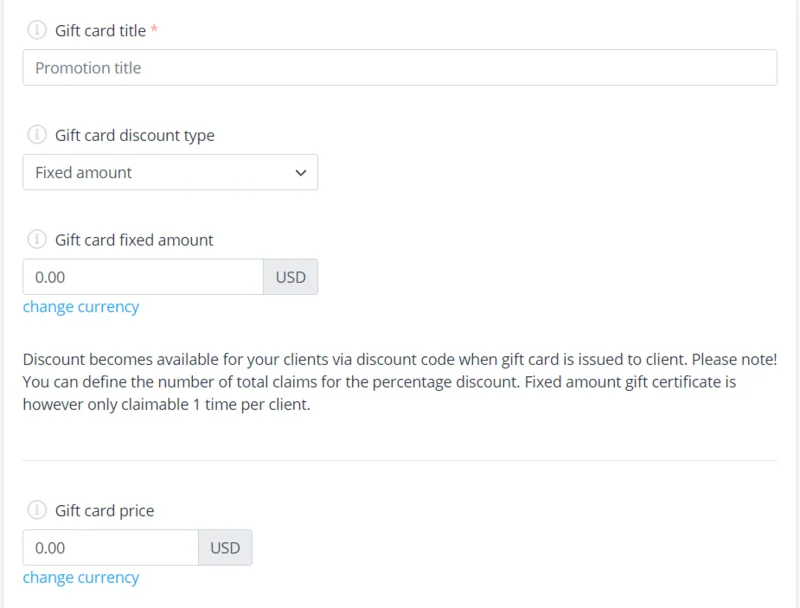
Analyze business performance
To know how well your company is performing, you’ll surely need an analytics tool that provides you with data on:
- total bookings
- number of booked, rescheduled and canceled appointments by service and service provider
- payments by service and service provider
If you send promo materials to users via email or SMS, you might also consider a report on the results of email and SMS campaigns.
In most cases, web apps for appointment scheduling come with their own custom analytics tools and dashboards that are simpler to use than Google Analytics, which is quite difficult to set up. Below is an example of a report by Simply Book.
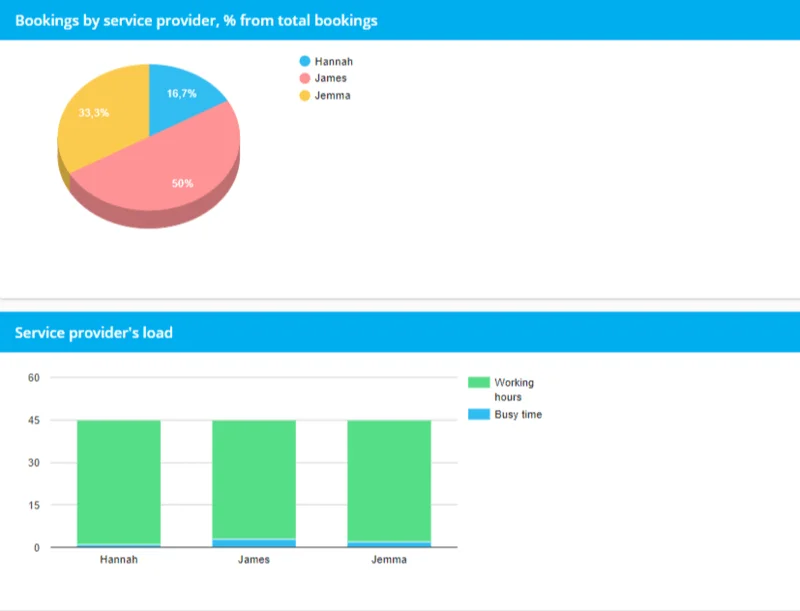
How can you reduce no-shows and cancellations?
When you allow customers to book online, there’s always a risk that they’ll schedule an appointment but not show up. According to Health Management Technology, the healthcare domain alone loses $150 billion a year to no-shows. This number may vary for different industries, but no-shows remain a large revenue drain.
Create a cancellation policy. For now, the best way to lower the no-show rate is to develop a proper cancellation policy – and users need to agree with it when booking. For example, you can restrict the time to cancel an appointment or charge a deposit that isn’t refunded in case the appointment is cancelled (make sure you mention that in your service terms and conditions).
Offer to add a customer to the waitlist. Waitlisting can help you fit in other people when there are no-shows, allowing another customer to fill an appointment if someone who originally booked doesn’t come on time.
Provide subscription or package deals. One more option is to switch to subscription or package deals after one or two appointments. Simply Book has a special integration to embed a cancelation policy in a service provider’s site, so you might think of using it.
Exclusive handy hints and tips from Yalantis
With the following hints and tips, you’ll be able to build an online scheduling solution that meets your business needs.
Don’t reinvent the wheel. Improve it!
There are lots of ready-made appointment scheduling products. Learn their advantages to adopt them and even improve on them. And try to identify drawbacks to avoid.
When developing an appointment scheduling app for a group of US clinics, we researched several solutions previously used by the client. As a result, our software development company built a product with easy user onboarding thanks to a familiar user flow. But unlike in solutions where all filters are hidden under confusing buttons, we reduced the number of filtering options and made filters visible right in the calendar.
Ensure scalability, flexibility, and usability from the very start
Take into account software systems you want your appointment scheduling solution to integrate with. Make sure you establish a software architecture that supports these integrations and allows for adding or improving functionality as your business grows.
The microservices architecture we build for our appointment scheduling products ensures that all services can be scaled and decomposed within the bounds of the API service. You can provide great usability through easy-to-navigate bulk editing, filtering, and pre-populated forms.
Keep in mind security issues
To provide maximum cyber security when exchanging data, start with assessing risks your business might face. Common practices used by experienced technology providers to ensure great security for appointment booking software are:
- data encryption
- activity logging
- setting session expiration times
- limiting the number of devices logged in to one account simultaneously
- complying with industry-specific regulations (e.g. HIPAA for healthcare organizations and GLBA for financial institutions)
Despite the variety of ready-made booking software, our clients often experience difficulties customizing this software to their needs. Moreover, onboarding staff to appointment scheduling platforms is often a challenging and long process. We hope this post has helped you find out how to create appointment scheduling functionality. If you want to delegate this task to an experienced scheduling system development provider, we’ll gladly help you add booking functionality to your website or application.
We’ll help you build an app with the appointment scheduling feature!
We’ve already built an event discovery platform for actors and created planner apps
Rate this article
4.3/5.0
based on 95 reviews




